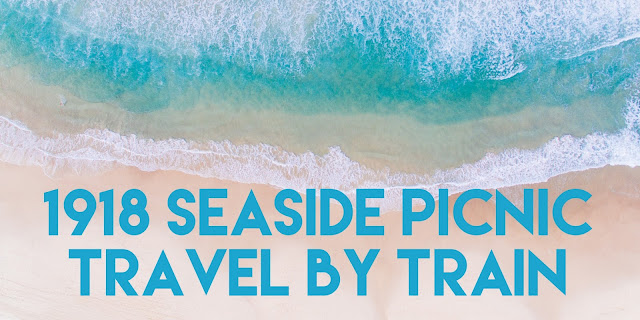The weather was hot.
Harvest was over.
Time for some fun.
A visit to the beach.
In 1918 motorised transport was still a luxury, but train travel was available through the mid-north region of South Australia. The Midland District Committee met in Tarlee to plan such an outing for their local communities.
A meeting of the committee of the Midlands Beach Picnic was held at Tarlee —that town being geographically the nearest for all concerned. Representatives from Hamley Bridge, Stockport, Linwood, Giles Corner, Tarlee, Riverton, Rhynie, Marrabel, Saddleworth, Auburn, Steelton, and Waterloo were present. Dr. Glynn occupied the chair. The hon. secretary of the picnic committee (Mr. J. Oswald Tayler, Tarlee,) submitted information relating to the last outing, and said the feeling regarding a continuance of the picnics was unanimous and enthusiastic. In view of the fact that 1,200 persons availed themselves of the opportunity to have a trip to the seaside last March, it was felt that no risk would be run in arranging a similar day this year. It was decided to carry on the fixture, and the date chosen was Thursday, February 21, the rendezvous to be Glenelg. A movement has begun to proclaim that date a close holiday for banks, stores, and all business places possible throughout the towns and communities participating in the picnic, and it is hoped no obstacle will occur to prevent this being accomplished. (1)
Much excitement ensued as tickets were purchased for the day out and food and drinks prepared. A large crowd was expected and tickets on the trains sold out quickly.
MONSTER BEACH PICNIC.Reports of the train journey and number of passengers appeared in several papers. It was a long day out for those with small children, a 6.45 am departure from the train station meant a very early start by horse and buggy to reach the town. By the time the trains arrived home at about 11 pm that night, weary beach goers then faced the long trip back home.
The Midland beach picnic at Glenelg to-day promises to be a great success. About 2,000 tickets have been sold. At Riverton every available ticket was sold, .and the railway-stationmaster has had to apply for more. Clare, Auburn, and Watervale are also booking for these excursion trains. A launch has been chartered for sea trips. On Saturday a similar excursion train is to be run from Burra. (3)
Our trips to the beach are easy and uncomplicated compared to the effort required by our ancestors. We hope they enjoyed the train trip with their friends and neighbours.
- 1918 'RIVERTON.', Kapunda Herald (SA : 1878 - 1951), 25 January, p. 3. , viewed 23 Jan 2018, http://nla.gov.au/nla.news-article108279615
- 1918 'Advertising', Glenelg Guardian (SA : 1914 - 1936), 7 February, p. 1. , viewed 23 Jan 2018, http://nla.gov.au/nla.news-article214714823
- 1918 'GENERAL NEWS.', The Advertiser (Adelaide, SA : 1889 - 1931), 21 February, p. 4. , viewed 23 Jan 2018, http://nla.gov.au/nla.news-article5599018
- 1918 'Advertising', Blyth Agriculturist (SA : 1908 - 1954), 1 March, p. 3. , viewed 23 Jan 2018, http://nla.gov.au/nla.news-article215156229












